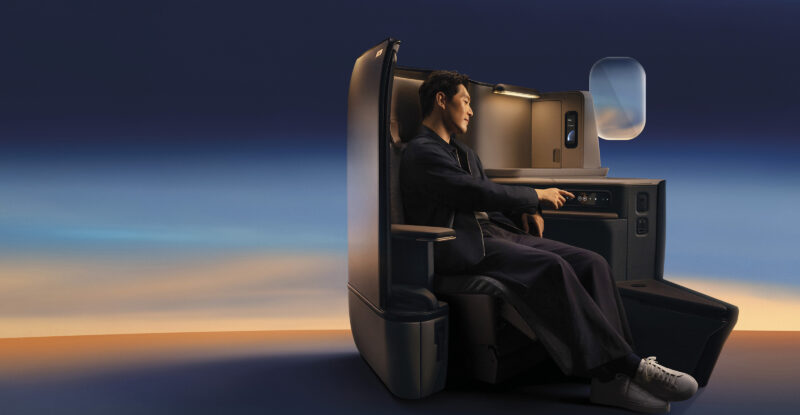 JPA Design’s portfolio spans aircraft cabin interiors, luxury hotels and resorts, VIP lounges for major airlines, and interiors for some of the world’s most iconic rail journeys. Now, as we prepare to wave goodbye to 2025 and usher in a new year, the award-winning design firm has identified five key trends that will shape the future of travel.
JPA Design’s portfolio spans aircraft cabin interiors, luxury hotels and resorts, VIP lounges for major airlines, and interiors for some of the world’s most iconic rail journeys. Now, as we prepare to wave goodbye to 2025 and usher in a new year, the award-winning design firm has identified five key trends that will shape the future of travel.
The Comfort Renaissance
Meaningful, Personalised Experiences at Every Stage of the Journey
As luxury becomes increasingly personal, travellers expect comfort that extends far beyond premium materials or conventional hospitality cues. In 2026, comfort will be redefined as a meaningful, individualised experience delivered seamlessly across every stage of the journey, from car to airport, cabin to hotel, residence to retreat.
Brands must design environments that intuitively respond to traveller needs, weaving emotional resonance, flexibility, and personal relevance into every touchpoint. Luxury is no longer simply about what is offered, it’s about what feels uniquely crafted for each guest.
Wellness Is the New Wealth
Redefining Luxury Through Health-Centred Design
Wellness has become the definitive marker of modern luxury, shifting from a desirable amenity to a foundational design principle. JPA has long championed this ethos, as seen in projects like Afterglow, where circadian lighting and sensory balance support traveller restoration.
In 2026, travellers increasingly prioritise health, seeking environments that nourish and uplift through natural light, ergonomic details, sustainable materials, and human-centric spatial design. Wellness now shapes the architecture of experience itself, redefining opulence as environments that enhance vitality and emotional equilibrium.

JPA designed Cathay Pacific’s Aria suite to offer superb comfort, privacy and practicality. Image: Cathay Pacific
The Future-Proofed Aesthetic
Sustainability and Flexibility Become Design Dual Forces
Sustainability and adaptability will converge to define a new design language where spaces evolve intelligently over time. As retrofitting, modularity, and material innovation accelerate across travel, hospitality, and residential sectors, travellers gravitate toward environments that offer flexibility without sacrificing beauty or longevity.
Airlines explore lower-density layouts and expanded “middle luxury” cabins, while hotels and residences reconfigure to meet shifting lifestyle patterns. Future-proofed design reflects a mindful balance: visually compelling, operationally resilient, and built with a long-term ecological perspective.
Branded Worlds
Cultural and Creative Collisions as Brands Continue to Expand Beyond Their Categories
As travellers seek reassurance, coherence, and meaning, they gravitate toward brands whose values, aesthetics, and intentions feel reliably genuine. In a world where authenticity is increasingly difficult to decipher, trusted brands become cultural touchstones, offering clarity, continuity, and a sense of emotional grounding. The shift toward trusted identity is prompting brands to expand into new spaces, driving the growth of branded residences, wellness-led hospitality, and design-forward mobility spaces.
In 2026, these brands extend far beyond their original categories to create holistic lifestyle ecosystems, where every touchpoint shares a unified design language and clear creative ethos.
Transportation adopts the intimacy of residential design, hotels embrace the narrative richness of cultural brands, and wellness companies expand into travel to craft environments that feel both exclusive and personally resonant. These branded worlds deliver belonging, coherence, and narrative depth, spaces that feel unmistakably part of a larger, trusted creative universe.
The Golden Age Reimagined
A Return to Rail, Sea, and Slow Travel, reinvented for the Future
Rail and marine travel are experiencing a renaissance not only for their sustainability and spatial freedom but because they embody a shift in mindset: in 2026, the journey itself becomes just as meaningful as the destination. As travellers seek richer, slower, and more intentional experiences, trains and sea-based journeys offer the opportunity to savour movement, engage with the environment, and enjoy personalised comfort along the way.
These modes of travel naturally lend themselves to hyper-personalisation, wellness-led design, and adaptive materiality that evolves over time. From elevated rail suites to reimagined marine and yachting experiences, these platforms support curated rituals, restorative moments, and a renewed sense of narrative immersion. Their growing appeal reflects a broader cultural desire for travel that is conscious, experiential, and deeply attuned to the emotional arc of the journey itself.
 About the authors, JPA Design:
About the authors, JPA Design:
JPA Design is a global design company with projects spanning luxury, transportation, interiors and product design sectors. With over thirty years of experience, JPA Design creates the environments, objects, buildings and vehicles of the future in partnership with the world’s most exciting brands.
Related Articles:
- United, Delta tout NPS and wellbeing benefits of seatback IFE
- Time for airlines to get switched on to cabin lighting promises
- Cathay refines mini-suite category to near-perfection with Aria
Featured image credited to Cathay Pacific












